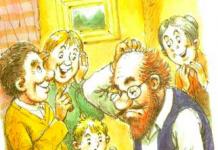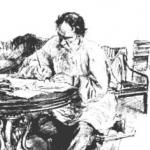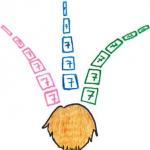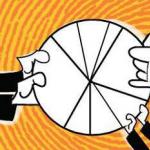In his fable “The Donkey and the Man,” Krylov ridicules another human vice called stupidity. What can stupidity lead to?! It can cause irreparable damage both materially and morally. The damage in the moral sense is very significant; after such damage, not everyone will be able to rise from their knees and start all over again. It is not for nothing that there are many folk sayings and proverbs warning us against stupid, thoughtless actions.
In the fable, the author considers two heroes: the Man and the Donkey. It is generally accepted that the donkey is a stupid animal, that is, by taking the Donkey as a character, Krylov, as it were, gives instructions in advance for his stupid actions and actions. But in the fable, the author puts the Man and the Donkey on the same level.
“The Donkey had the most honest rules,” honor comes first for him, and he treats his service to the Man honestly. The donkey honestly guarded the Peasant's garden, did not take a single leaf from it, and drove away the crows with such tenacity that he trampled all the Peasant's crops. The donkey unwittingly caused significant damage to the Man, against the background of which all his honesty was worthless, all his efforts turned out to be of no use to anyone. The question arises, why was this Donkey’s honesty needed then? With this plot, the author shows us irony and bitterness at the same time. Why adhere to some rules when you yourself do not realize their importance? Donkey's stupid and thoughtless act ruined all his efforts.
The man, in turn, acted twice as stupid as the Donkey. First he hired Donkey, and then he took out his anger on him. But the Man himself is to blame for this situation. Where was he when the donkey was trampling the garden? It turns out that he hired Donkey as a security guard and left everything to chance, never came in, didn’t check how things were going, whether Donkey really had honest rules. We see another stupid and thoughtless human act.
But the Man, as all people love to do, finds an excuse for himself. No wonder they say: “If you have strength, you don’t need intelligence.” And seeing that all his work was lost, “The peasant on the back of a donkey, took out the loss with a club.”
So who is more stupid in the fable, man or animal?! Whose stupidity was greater? In my opinion, the guy looks stupider here, he hires a stupid Donkey, doesn’t look at his actions, and then also takes out his anger on the animal. Many people do the same in their lives. We do many stupid things that harm others and ourselves. You can morally humiliate any person, but why? We need to be more careful and thoughtful about our actions, think about every step we take, and then we will insure our actions against stupidity and thoughtlessness.
The man decided to hire a Donkey to guard the garden from crows and sparrows. The donkey turned out to be very honest and diligent, he did not eat a single leaf of the owner and conscientiously drove the birds away from the peasant’s garden.
I am unfamiliar with neither rapacity nor theft,
He didn’t profit from a single leaf from the owner, And it’s a sin to say that he gave a treat to the birds...
Despite such diligent work of the Donkey, the Man was left without a harvest. After all, the Donkey, chasing the birds, trampled all the vegetables in his garden, “crushed and trampled everything.” Seeing what the Donkey had done, “the peasant on his back
with a donkey \ He avenged the loss with a club.” At the same time, the Man said:
And nothing! - everyone shouts, “serves the beast right!”
Is it with his intelligence that we take on this matter?
And I will say, not to stand up for the Donkey;
He is definitely to blame (and the settlement has been made with him),
But it seems that he is also wrong
Who instructed the Donkey to guard his garden.
The moral of the fable is this: you should not entrust an important task to a fool, because it is known in advance that he will not cope with the task.
Otherwise, the person who entrusted the matter to an incompetent person should be blamed.
Glossary:
- guy fucks donkey
- man fucks donkey
- analysis of the fable the donkey and the man
- Analysis of the fairy tale the donkey and the man
- history of the creation of the fable the donkey and the man
(No ratings yet)
Other works on this topic:
- Donkey and Nightingale One day Donkey saw Nightingale and said that he had heard about his ability to sing. Listen up, buddy! You, they say, are a great master of singing. I would really like...
- The Mirror and the Monkey The characters in this fable are the Monkey and the Bear. The monkey saw her reflection in the mirror, but did not recognize herself in this reflection. She decided,...
- Pig under the Oak In this fable, in the image of a Pig, the author ridiculed human vices - greed, ingratitude, brute force that does not listen to the voice of reason....
- Analysis of the work This is a continuation of a series of revealing tales by M. E. Saltykov-Shchedrin. The story satirically ridicules not the generals themselves, but the foundations of Russian life. Well-being is based on great...
The 1830 fable “The Donkey” tells many interesting things about the Donkey. Let's consider it
content. The peasant had a Donkey. He behaved so meekly that he could not praise him enough. That is, here our hero appears almost in his animal nature. He is not noble, does not have dignity, no Fox is promoting him anywhere - he is simply an Ass in the authenticity of his nature. Natural Donkey. Not even allegorical yet. But the man, so that the Donkey could not disappear in the forest, hung a bell around his neck. There is also nothing allegorical yet. But that's where it all started. The donkey pouted: he began to be proud, to put on airs:
(Of course, he had heard about the orders),
And he thinks that now he has become a big gentleman...
Since this all started.
And, following the fable allegory, we must say that the Donkey himself is not stupid. But he becomes stupid before our eyes as soon as they make him into a noble gentleman. Donkeys are not stupid - the nobility is stupid - that’s what bursts from the tongue of the great fabulist. Nobility is stupid, arrogance is stupid, undeserved pride is stupid, like everything undeserved. This discrepancy between nature and position in society stupefies a person, makes him, according to Krylov, “pout”, awakens dormant bad instincts in him - previously dormant arrogance and arrogance.
This is how Donkeys are born. They are not gestated in the womb and are not born into the light of day in a stable. Senatorial seats are the cradle of Donkeys.
This seems to be the logic of this story. Although Krylov himself interprets it differently. Let's take a closer look. There was not much honor in the “big gentleman”. He loved to visit other people's gardens and crops. But before receiving the rank he got away with it. Now everything has gone differently:
Wherever my noble lord goes,
A new rank rings incessantly around the neck.
And the Donkey's sides are turned with a stake.
So much so that the nobleman withered away until the fall. Only bones and skin remained with the Donkey. Of course, it is tempting to interpret the fable in the spirit of: a “nobleman”, a “noble gentleman” is beaten with a club. But this does not work: before us is an imaginary nobleman. True, there is no way to analyze Krylov’s fables separately, because they are whole, united and indivisible. And the image of the Donkey as a whole sheds some light on the fable that we are now analyzing. But for all that, this fable also speaks of something else. About what? The poet himself interpreted his story this way:
And among people in ranks
It’s the same problem with rogues: while the rank is small and poor,
The rogue is not yet so noticeable;
But an important rank on a rogue is like a bell:
The sound from it is both loud and distant.
The moral does not even remotely fulfill the fable's story: a rogue with an important rank is no longer a rogue. He will never be thin.
The Donkey fable had the potential to develop into something significant. The allegory worked quite energetically, the flow of the story was simple and natural. But before “application” the poet hesitated. An important rank has not become either a mark on the rogue, or a loud and distant bell; rather, the opposite is true - the rank does not ring about the rogue, but helps him bury his loose ends. The fable as an organic artistic whole did not work out.
But it’s time for us to start talking about the artistic activities of our nobleman. Here, as elsewhere, he is a nobleman. Place, rank, the right to sentence - these are the main things in Donkey, who probably had some kind of honorary title.
This article contains summaries of 47 of the most famous fables by Ivan Andreevich Krylov
Krylov, fable “The Wolf and the Lamb” - summary
Moral of the story: “The powerful are always to blame for the powerless.”
On a hot day, a lamb went to a stream to drink. A hungry Wolf ran past, who decided to kill and eat the Lamb, but “to give the matter a legitimate look and feel.” Running up to the Lamb, he first began to say that he was muddying his clean drink with his unclean snout. The Lamb made an excuse that he was drinking a hundred steps below the Wolf’s watering hole. The Wolf, not embarrassed, immediately accused the Lamb of being rude to him “last summer.” But it turned out that the Lamb was not even a year old. Then, without listening to further excuses, the Wolf growled: “It’s your fault that I want to eat” - and dragged the Lamb into the dark forest.
Krylov "Wolf and Lamb". Artist E. Rachev
Krylov, fable “The Wolf in the Kennel” - summary
The wolf, thinking at night to get into the sheepfold with the sheep, ended up in the kennel, among the hunting dogs. The dogs began to bark and the hounds came running. Driven into a corner, the Wolf, out of cunning, started negotiations: he offered his friendship, promised not to touch the local herds anymore. “You are gray, and I, my friend, am gray,” the hunter interrupted him. “And I’ve known your wolfish nature for a long time.” I make peace with wolves only by skinning them.” And then he released a pack of hounds at the Wolf.

Krylov "Larchik". Illustration for the fable
Krylov, fable “Swan, Pike and Cancer” - summary
“When there is no agreement among the comrades, their business will not go well.” One day Swan, Cancer and Pike began to carry a cart with luggage and harnessed themselves to it. But “The Swan rushes into the clouds, the Cancer moves back, and the Pike pulls into the water.” Even though they are all trying their best, “the cart is still there.” (See the full text of the fable.)

Krylov "Swan, Pike and Cancer"
Krylov, fable “Lion on the hunt” - summary
The Dog, Lion, Wolf and Fox agreed to divide among themselves equally all the prey that each of them caught. The Fox was the first to catch the deer. Three of her comrades agreed on a division. The lion tore the deer into four, took the first part for himself “according to the agreement”, the second - also for himself, “like a lion”, the third - because he is the strongest of the four, and about the fourth he warned: “whoever of you stretches out his paw to it will he won’t get up from his spot alive.”
Krylov, fable “Liar” - summary
A lover of lies, “returning from distant travels,” told an acquaintance about the wonders of overseas countries. He insisted that there was no night abroad, but in Rome there was a cucumber the size of a mountain. The liar's interlocutor noted that there are many miracles in Russia. For example, the bridge they are now approaching is special: not a single liar can cross the river on it - he will definitely fall into the water. The deceiver who arrived from abroad immediately began to say that the Roman cucumber is perhaps not the size of a mountain, but the size of a house, and that houses in Italy are very small. Approaching even closer to the river, the liar suggested to his friend not to go to the bridge, but rather to look for a ford.
Krylov, fable “The Fox and the Grapes” - summary
The hungry Fox climbed into the grape garden, but could not get a single juicy brush: they all hung too high. Having spent an hour in vain, the Fox walked away, saying that the grapes were sour and unripe - they could only set one’s teeth on edge.
Krylov, fable “The Fox and the Marmot” - summary
The Woodchuck met the Fox, who complained to him that she had been unfairly deprived of her position in the chicken coop for bribes. Lamenting, the Fox told how, among the chickens, she didn’t get enough sleep at night and didn’t have enough to eat, but still became a victim of slander. “No, gossip, I have often seen that your snout is covered in fluff,” replied the Marmot.
So, says Krylov, even among officials many swear that they are honest, do not steal and live out their last ruble, “but you look, little by little, he will build a house, then he will buy a village.”
Krylov, fable “Leaves and Roots” - summary
On a beautiful summer day, the lush leaves of one tree were boasted of their beauty and density, the fact that they provide shade for shepherds to rest and attract dancers and singers under their canopy. “We might as well say thank you here,” a voice suddenly rang out from underground. The sheets asked who dared to object so arrogantly. “We are the roots of the tree that nourish you,” was the answer. “Show off, but remember that you are renewed every spring, and if the root dries up, then neither the tree nor you will exist.”
Krylov, fable “The Curious” - summary
One Curious One visited the Kunstkamera (exhibition of curiosities) and told a friend that he saw there tiny bugs and boogers smaller than the head of a pin. “What is an elephant like? - asked a friend. “After all, he’s there too.” “I didn’t even notice the elephant,” Curious threw up his hands.
Krylov, fable “The Frog and the Ox” - summary
The frog, seeing a huge Ox in the meadow, wanted to match his size. She began to puff and swell with all her might - until she burst.
Moral of the story: among ordinary people, many want to be like noble nobles and live like them - but they try in vain.
Krylov, fable “Frogs asking for the Tsar” - summary
The frogs in the swamp were tired of democracy, and they began to ask Zeus for a king. The Supreme God responded: the Monarch, a large aspen block, fell from the sky into the swamp. Since the log was large, the frogs initially hid in fear, but then, becoming bolder, they began to crawl towards it. Those who were far away began to jump very close to the “king”, some even sat astride him, but he just remained silent. Having quickly become bored with such a king, the frogs began to ask Zeus for another. He sent the Crane to the swamp. This sovereign did not spoil his subjects. His right-wingers were not present at the trial. Declaring everyone guilty, the Crane immediately ate everyone. Such a king turned out to be much worse for the frogs than the first. They again began to ask for something new. But Zeus said that since neither his first nor second choice pleased him with frogs, let them live with the king who is.
Krylov, fable “The Monkey and the Glasses” - summary
The monkey began to see poorly as he grew older. Having heard from people that Glasses could help with this, she got herself half a dozen of them. But the Monkey did not know how to use the Glasses: she either pressed them to the crown of the head, then hung them on her tail, then sniffed them, then licked them - and without achieving any sense, spitting on people’s lies, she broke the Glasses on a stone.
So, the ignorant, says Krylov, not knowing the value of a useful thing, degrade it, and the ignorant, more knowledgeable, drive away this thing.

Krylov “The Monkey and the Glasses”
Krylov, fable “Sea of Animals” - summary
The kingdom of animals was subjected to a terrible pestilence. Leo, having called all the forest and steppe inhabitants, proposed to try to stop the pestilence by making a sacrifice to the gods. This victim was to be the most sinful of animals. Leo himself immediately confessed his sins: he often innocently tore sheep, and sometimes even shepherds. The Fox who ran out said that this is not a great sin at all: the sheep are even honored that they are eaten by the king of beasts himself, and the shepherds are the common enemies of all predators. Other strong animals - Bear, Tiger and Wolf - also repented of grave sins, but looking at their claws and teeth, those gathered admitted that they had no serious offenses. But when the peaceful herbivore Ox admitted that once during a famine he had stolen a piece of hay from the priest, the meeting of animals began to roar with indignation. The ox was doomed to be sacrificed and thrown onto the fire.
Krylov, fable “Musicians” - summary
One neighbor, who highly praised his singers, invited another to come over and listen to them. The musicians started bawling loudly, but without any harmony or order - “some are going to the forest, some are looking for firewood.” A neighbor-listener noticed that “the choir is bawling nonsense.” “You’re right,” the person who invited him answered. “But all my musicians don’t take anything drunk.”
“For me, it’s better to drink, but understand the matter,” Krylov draws the moral.
Krylov, fable “Oboz” - summary
A convoy with pots was descending a steep mountain. Harnessed to the first cart, the good horse began to slowly lower the load of pots down the steep slope. The young horse walking behind began to scold the good horse: he, they say, walks too carefully, and at the same time sometimes catches the cart on the stones. But when it was the horse’s turn to go down with his cart, he could not withstand the pressure of the load, began to throw himself sideways, fell into a ditch and broke all the pots.
And in people, says Krylov, there is often a noticeable weakness in exposing other people’s mistakes. And as soon as you get down to business, you will “punish twice as bad.”
Krylov, fable “The Donkey and the Nightingale” - summary
Having heard that the nightingale is a great master of singing, the donkey asked him to show him his art. The nightingale burst into a wonderful trill, which people and nature listened to. The donkey restrainedly praised the nightingale and advised him, in order to “get more sharp” in singing, to learn from the yard rooster.
“God, deliver us from such judges,” is Krylov’s moral.
Krylov, fable “Parnassus” - summary
When the pagan gods were driven out of Greece, donkeys began to graze on Mount Parnassus, where the muses (nine goddesses of the arts) had previously lived. Having learned that the muses used to sing beautiful songs on Parnassus, the donkeys decided to imitate them. The herd of donkeys began to roar at the top of their lungs, “as if a wagon train with thousands of unoiled wheels had started moving.” The owner came running and hurried to drive the donkeys back into the barn.
Krylov’s moral: “if the head is empty, then the head of the mind will not be given space.”
Krylov, fable “The Hermit and the Bear” - summary
Moral of the story: it’s good when one tries to serve the other. But if a fool gets down to business, then his services are often more dangerous than the enemy’s machinations.
A hermit living in the desert suffered from loneliness. To make a friend, he went into the forest and met the Bear there. The Hermit and the Bear became inseparable. One day they wandered together all day. The hermit was tired and went to bed. The kind, but simple-minded Bear, watching over his comrade's sleep, began to drive away with his paw a fly that had landed on him. She was so persistent that the Bear decided to kill her. Taking a huge cobblestone, he hit the fly that landed on the Hermit’s forehead - and cracked his friend’s skull.
Krylov, fable “The Rooster and the Grain of Pearls” - summary
The rooster, who found a pearl grain in a dung heap, decided that this was a completely empty thing, much more useless than a nourishing barley grain.
Moral of the fable: “The ignorant judge exactly this way: whatever they don’t understand is of no use to them.”
Krylov, fable “The Picky Bride” - summary
The girl-bride was looking for a groom, but was too picky. At first, noble and eminent people wooed her, but she found shortcomings in everyone: one without ranks, another without orders, the third had a wide nose... After two years, there were already fewer suitors - and people of “middle class” began to woo. The picky bride was in no hurry to reciprocate their feelings. As time went. The bride has already become a “mature maiden.” Her beauty has faded. The grooms almost stopped wooing - and the bride “was already glad that she married a cripple.”
Krylov, fable “Pig” - summary
The pig, having climbed into the manor's yard, according to its custom, rolled there in the slops and returned home up to its ears dirty. The shepherd asked what wonders she had seen among the rich, where, they say, everything was full of beads and pearls. The pig replied that she did not notice the wealth, saw only manure and rubbish, and dug up the entire back yard with her snout.
Krylov compares with this pig a mediocre literary critic, who “no matter what he examines, has the gift of seeing only bad things.”
Krylov, fable “The Pig under the Oak” - summary
The pig ate acorns under the Oak, slept and began to undermine the roots of the tree with its snout. “This could cause the tree to dry up,” a raven sitting on a branch told her. “Let it be,” answered the Pig. “It’s of no use to me, if only it were acorns.” “If you lifted your snout up, you would see that acorns are growing on me,” said Oak.
So the ignoramus, notes Krylov, scolds science and learning, without feeling that he is tasting their fruits.

Krylov "Dragonfly and Ant". Artist O. Voronova
Krylov, fable “Trishkin caftan” - summary
Trishka’s caftan was torn at the elbows. Without thinking twice, he cut off the sleeves and sewed up the hole. However, now everyone was laughing at the short sleeves of Trishkin’s caftan. “Well, I’m not a fool and I’ll fix that problem,” said Trishka. He cut off the tails and skirts, adjusted the sleeves, but his caftan was now shorter than his camisole.
So some gentlemen, having confused matters, correct them in the manner of Trishkin’s caftan, writes Krylov.
Krylov, fable “Cloud” - summary
A large cloud swept over the region exhausted from the heat, but then it rained heavily over the sea - and boasted of this generosity before the Mountain. “There is enough water in the sea without you,” answered the Mountain. “And then you could save the whole region from hunger.”
Krylov, fable “Fortune and the Beggar” - summary
The poor beggar, looking at the rich, was surprised at their greed. Many made huge fortunes, but in order to double them further, they embarked on risky transactions - and in the end lost everything. The goddess of fortune Fortuna, taking pity on the Beggar, appeared to him and offered help. Fortune promised that she would pour as much gold into the Beggar’s old bag as it could bear, but with a condition: if the Beggar himself did not stop this flow in time, and the gold with its weight broke through the bottom, then, having poured out onto the ground, it would turn to dust. Fortune began to pour gold into the bag. Due to its dilapidation, it soon began to crack, but the Beggar, who had previously condemned the rich, now, out of greed, did not stop the golden rain until the bottom of the bag broke through and the spilled gold turned to dust.
Krylov, fable “Siskin and Dove” - summary
Chizh fell into a trap. Young Dove began to laugh at him, saying that he wouldn’t have been tricked like that, but then he himself got caught in the snare. “Don’t laugh at someone else’s misfortune, Dove,” concludes Krylov.
Krylov, fable “Pike and Cat” - summary
“It’s a disaster if a shoemaker starts baking pies, and a cake maker starts making boots.” No one should take on someone else's craft. One day, Pike, who was good at catching ruffes, began to ask the Cat to take her with him on a mouse hunt. The cat tried to dissuade her, but Pike was stubborn, and the two of them went to the barn. The cat caught a lot of mice there, but the pike lay without water, its tail, barely alive, was eaten off by rats. The cat with difficulty dragged the half-dead Pike back into the pond.
Description of material: I offer you a summary of a literature lesson in grade 5 on the topic: “Fables by I.A. Krylova". This material will be useful to teachers of Russian language and literature in primary secondary schools.
Summary of a literature lesson in grade 5 on the topic “Fables by I.A. Krylova"
Target: develop the ability to analyze the text of a fable.
Tasks:
Get acquainted with the biography of I. A. Krylov.
To form a concept about the fable genre and its features.
Analyze I.A.’s fable. Krylova.
Develop attention to literary text.
Equipment: portrait of I.A. Krylova, presentation, media projector.
Methodical techniques: conversation - dialogue, analysis, study of illustrations and conversation on them, comparative analysis of texts, reflection.
During the classes.
Organizing time.
Introduction to the topic of the lesson.
Guys, today is October 23rd. October is the second autumn month. Which one of you likes autumn? What do you like about this time of year?
And here is what the great Russian poets said about autumn.
“The sky was already breathing in autumn,
The sun shone less often,
The day was getting shorter
Mysterious forest canopy
stripped herself naked with a sad noise.” (A.S. Pushkin).
"Late fall. The rooks have flown away
The forest was exposed, the fields were empty.” (N. Nekrasov).
"There are in the brightness of autumn evenings
Touching mysterious charm:
The ominous shine and diversity of trees,
A languid, light rustle of crimson leaves.” (Tyutchev F.I.).
“The forest has crumbled its peaks,
The garden has revealed its brow,
September has died, and dahlias
The breath of the night burned.” (A.A. Fet).
(Portraits of poets are projected onto the screen: A.S. Pushkin, N. Nekrasov, F.I. Tyutchev, A.A. Fet).
Tell me, in what century did these poets live and work? (At 19)
We are moving from the study of folklore to the study of literature of the 19th century.
Works that excite the reader for a long time, arouse his interest, make him worry, are called classics. Literature of the 19th century is called classical.
Why do you think? (because it is still studied and read).
Writers and poets who created such masterpieces are called classics.
Announcing the topic of the lesson.
One of the classic writers of the 19th century is Ivan Andreevich Krylov. It is his work that we will get acquainted with today. (A portrait of Krylov is projected onto the screen.)
Work on the topic of the lesson.
Communication of biographical information.
I.A. Krylov. Born in 1769 into a military family. The boy's childhood was not easy.
Krylov was brought up at home, was taught Russian literacy, 4 rules of arithmetic and prayers. As a teenager, Vanya Krylov began working in the office. He passionately loved to read, but the boss, catching him reading a book, sometimes hit him on the head and shoulders and complained to his father, who also punished Krylov. While continuing to serve, Krylov mastered the French and Italian languages, and also learned to play the violin. His talent as a writer was noticed.
Guys, who knows what Krylov became famous for? (fables).
Krylov wrote his first fable at the age of 11. During his life, Krylov published 9 books one after another, containing more than 200 fables. I. A. Krylov is a fabulist. Krylov died in 1844. In the summer garden of St. Petersburg there is a monument to Krylov, created by the sculptor Pyotr Klodt. This is the first monument to a fabulist in Russia. It was created with public money collected throughout Rus'.
Guys, what Krylov fables do you know? (children’s answers).
Working on a definition.
Let's write down what a fable is.
A fable is a short, most often poetic story, in which a moralizing and at the same time satirical image of life is given in an allegorical (allegorical) form.
Why is a fable a story? (reports some event, has a plot).
Why is the story poetic? (fable is most often in verse)
Allegory (allegory) is an artistic means that speaks about the vices of people, disguising them behind images of animals.
Satirical - ridiculing vices.
The fable also contains personification.
Personification is a technique in which human qualities are attributed to animals. (students write in notebooks).
There are 2 parts to a fable: narrative and moral.
Morality is a moral teaching expressed in a short form. (students write in notebooks).
The language of fables is very aphoristic.
An aphorism is a short saying that expresses a deep thought.
Working with the fable “The Pig under the Oak”
Reading a fable by one of the students.
(An illustration of the fable is projected onto the screen.)
Guys, let's prove that this is a fable.
In what form is it written? (in poetry)
What is its volume? (small).
Does it have a plot? (Yes).
Select 2 parts. (Narration of the pig's act and morality)
Is there any allegory here? (yes, the main characters are animals, but they mean people).
Who are the main characters? How many are there? (Pig, raven, oak, 3).
Guys, what is the name of a 2-person conversation? (dialogue).
And in our fable we see a conversation between three people. This is called polylogue.
Let's write it down: polylogue is a conversation between several people.
Let's pay attention to the illustration. What episode is depicted on it? (conversation between a pig and a raven).
What action did the pig perform before this? (she ate acorns, then began to undermine the roots of the oak tree).
What did she answer to the oak tree when it reined her in? (that she doesn’t care about oak, the main thing is that she is well-fed).
What contradiction can be seen in the pig's words? (she wants to be full, but at the same time she destroys the tree on which acorns grow).
Why is she doing this? (she just doesn’t think about it, doesn’t understand and doesn’t want to know.
What human qualities does the author expose in the pig? (limitedness, indifference to the world, ignorance).
Guys, in the Russian language there are 2 similar words - ignoramus and ignoramus.
Let's write it down: An ignoramus is an ill-mannered person. An ignoramus is a person who does not want to learn. This pig is both ignorant and ignorant at the same time.
Guys, did you know that the fable genre originated in ancient Greece. The first fabulist was a man named Aesop. Therefore, the language of fables is usually called Aesopian language. Let's write down the definition.
Aesopian language is the ability of fabulists to disguise what they want to say.
Working with the fable “Oxen and the Axle”
Reading a fable. (The text of the fable is projected onto the screen.)
What is special about the fable? (not written in verse, one of the characters is an object) An axle is a part of a cart that connects the wheels to each other.
What situation? (the oxen are pulling the cart, and the axle is complaining that it is hard for her).
Who is being ridiculed in the fable? (about people who do their work honestly and about people who just pretend and, at the same time, complain about life.).
What human qualities are being condemned here? (laziness, unwillingness to work, constant dissatisfaction).
Work on the fable “The Donkey and the Man”.
Reading a fable (read by 2 students)
How a donkey handled his responsibilities (very responsibly, honestly, with zeal. He chased birds. He didn’t steal anything himself).
Why did the man punish him? (he trampled the entire garden)
Do you think the donkey did this on purpose? (No).
Why did this happen? (the donkey was stupid).
So who is more to blame? Stupid ass or the guy who hired him? (man)
What is the moral of this fable? (don’t trust responsible work to someone who can’t handle it. And if you do, then take responsibility for the consequences yourself. Don’t demand from others what they are not capable of.) (write in a notebook).
Summing up the lesson.
What section of literature have we started studying today? (19th century literature).
Which writer did we meet today? (I. A. Krylov).
What is he famous for? (with his fables).
What is a fable? (A fable is a short, most often poetic story, in which a moralizing and at the same time satirical image of life is given in an allegorical (allegorical) form).
What main features of the fable do you know? (personification, allegory, morality, aphorism).
Homework
Learn by heart one of two fables.
Optional: make an illustration for any of Krylov’s fables.




















